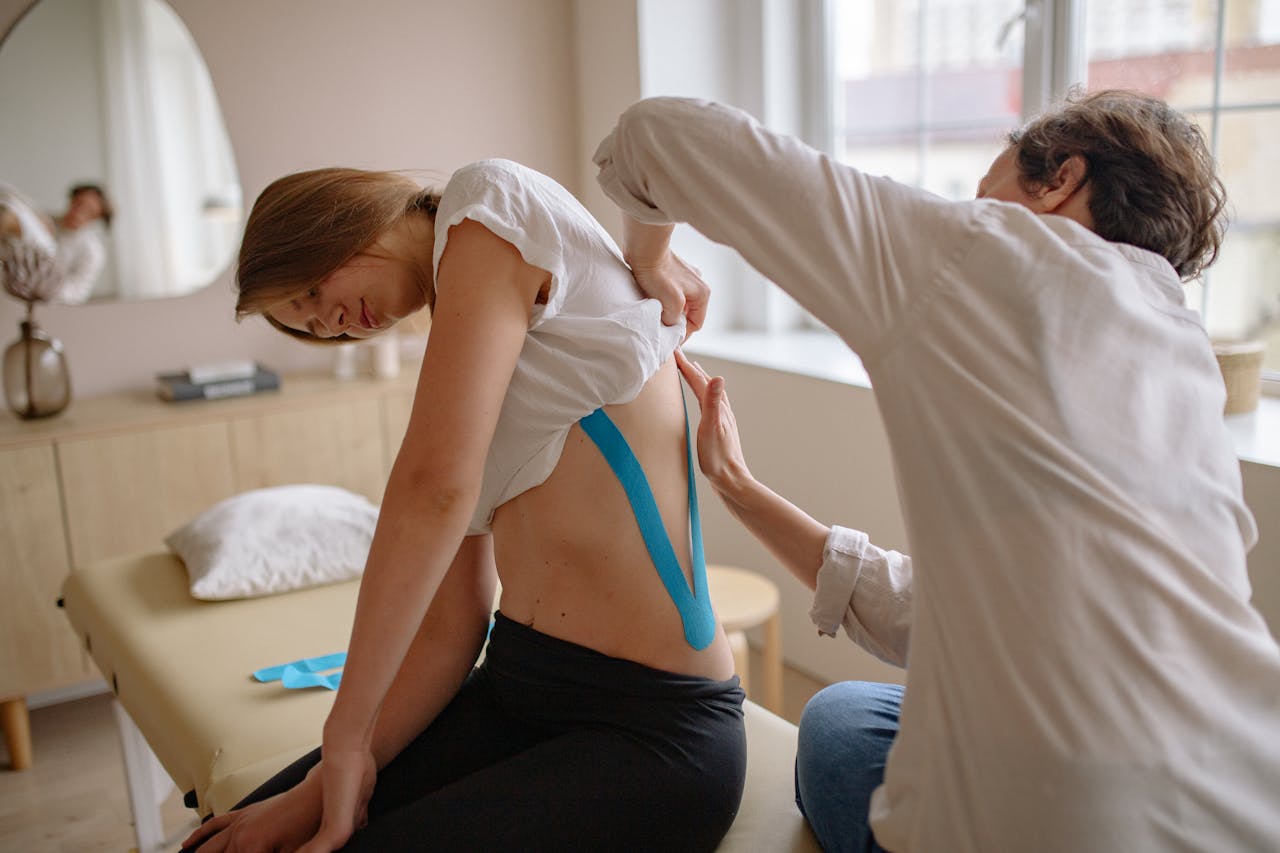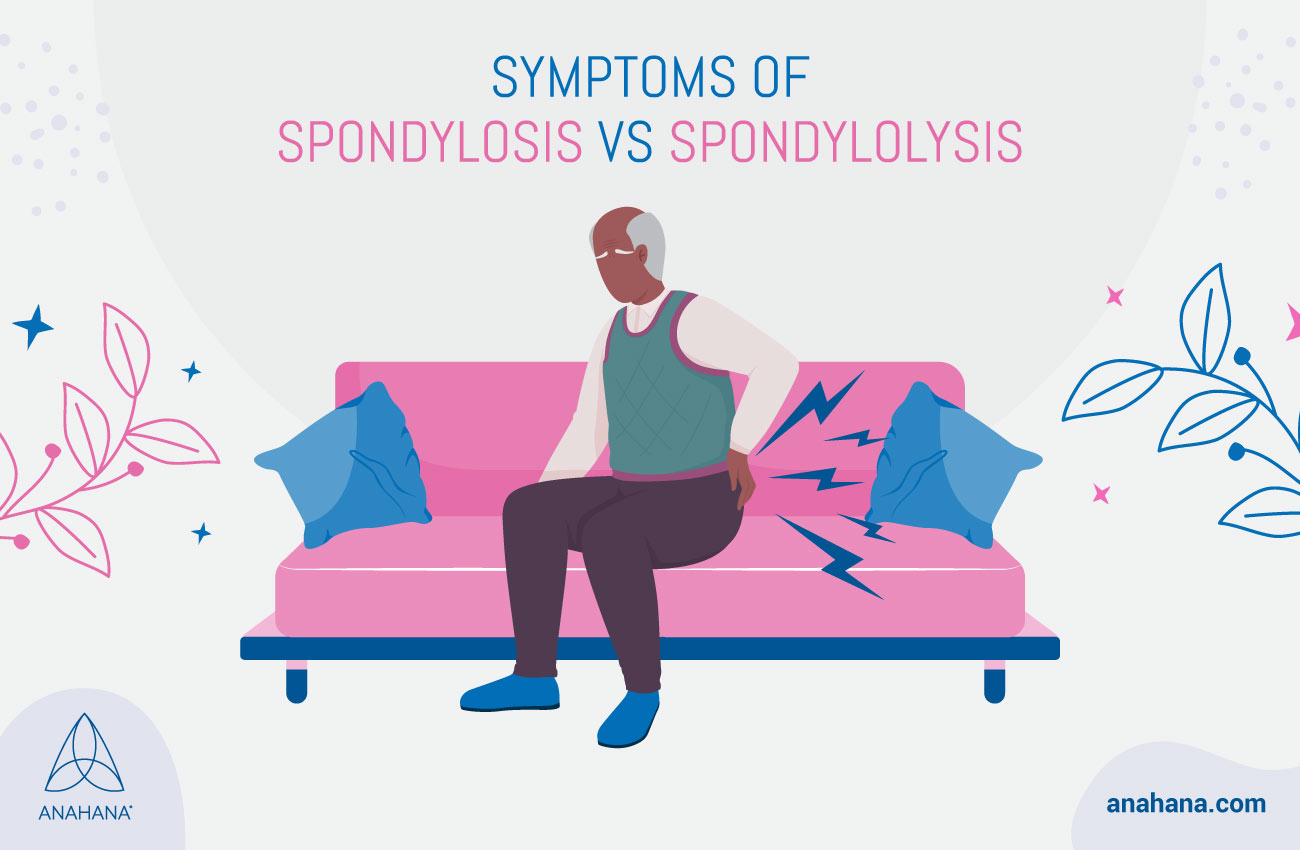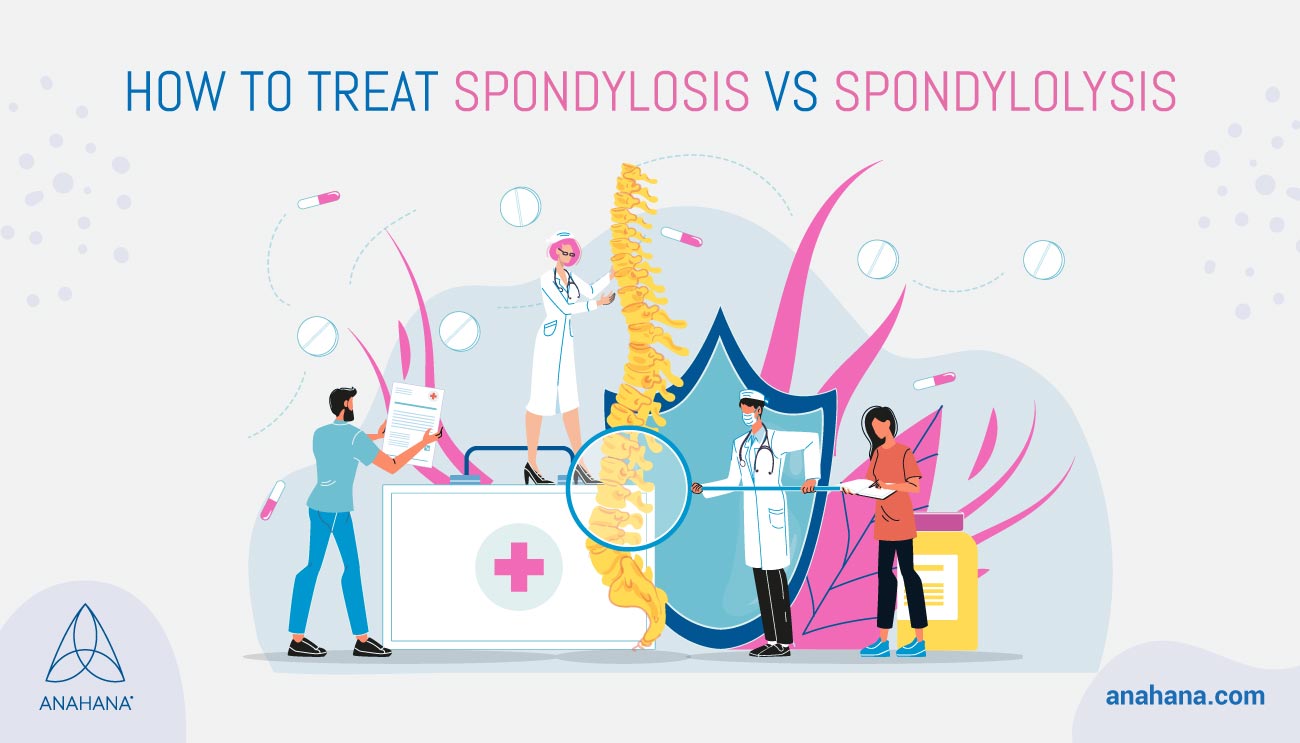4
Spondylosis Vs Spondylolysis
Last Updated: November 4, 2024

Table of Contents
Understanding the major differences between two spinal disorders and treatments that can help relieve both.
Key Takeaways
- Definition: Spondylosis involves spinal degeneration, while spondylolysis is a stress fracture in the spine's pars interarticularis, often leading to spondylolysis and spondylolisthesis.
- Symptoms: Spondylosis causes back pain, stiffness, and muscle spasms; severe cases may cause muscle weakness and loss of bladder control. Spondylolysis symptoms include low back pain and leg pain, often due to repetitive stress.
- Risk Factors: Spondylosis risk factors include aging, obesity, and a sedentary lifestyle. Spondylolysis is common in young athletes.
- Treatments: Include physical therapy, pain medications, yoga, and surgery such as spinal fusion with a bone graft or laminectomy to decrease pain.
- Diagnosis: Diagnosed through physical exams, X-rays, MRI, and CT scans.
What is Spondylosis
Spondylosis is a general term that describes spinal degeneration. Spondylosis is usually in the upper spine, called the cervical spine. Spondylosis can be spinal degenerative osteoarthritis or degenerative disk disease. Spinal osteoarthritis describes the wearing down of the protective cartilage surrounding the vertebrae's ends. The ends of the vertebrae are called facet joints and are the connections between vertebrae that allow for spine movement. Wearing down the cartilage of facet joints causes decreased space between the vertebrae. This reduced space can put pressure on the spinal cord and spinal nerve roots and causes inflammation and pain.
This pain can range from mild to severe pain. Degenerative disc disease describes the wear and tear of the spinal discs. The spinal disks act as shot absorbers and provide structure to the spine. Degenerative disc disease may develop due to water loss in the discs or small cracks formed in the discs. Osteoarthritis and degenerative disk disease usually occur in older age because of natural wear and tear on the spine.
What is Spondylolysis
Spondylolysis is a weakness or stress fracture of the spine, specifically the pars articularis. The pars Articularis are part of the ventral bone and are the bridge that connects the vertebrae's upper and lower facet joints. Spondylolysis in the lower spine, also known as the lumbar region. This fracture/weakening of the pars Articularis can cause the vertebrae to slip forward and out of place in the spinal column.
Spondylolysis usually affects the younger population. Repeated stress on the spine, heavy lifting, or participating in certain sports, which may cause repetitive trauma, such as gymnastics and football, is the most common cause of Spondylolysis. Spondylolysis and Spondylosis can be related as Spondylosis causes weakness in the spine, and if left untreated, it could lead to an injury that leads to Spondylolysis.
Symptoms of Spondylosis vs. Spondylolysis
 The most common symptom of both Spondylosis and Spondylolysis is back pain.
The most common symptom of both Spondylosis and Spondylolysis is back pain.
Spondylosis symptoms often start mild and increase over time or can increase very suddenly. Stiffness and pain are often felt, especially after long periods of sitting. Pain can spread across shoulder blades and into the upper arms. Some more severe symptoms of Spondylosis are muscle weakness, muscle spasms, headaches, loss of balance, and loss of bladder control.
Mild Spondylolysis may cause no symptoms or only mild symptoms. Occasionally Spondylolysis has been found with an x-ray without any symptoms. In more severe cases, people may experience more pain can prevent normal movement and functioning. Some common symptoms of Spondylolysis are low back pain and stiffness, sciatica pain, and leg pain while walking.
Risk factors of Spondylosis vs. Spondylolysis
Spondylosis most often occurs due to aging and wear and tear on the spine. One of the risk factors of Spondylosis includes genetic predispositions. Women over the age of 40 may develop decreased bone density which may predispose them to Spondylosis. Another risk factor for Spondylosis is a sedentary lifestyle and obesity. In addition, repetitive weight bearing is a risk for developing Spondylosis.
Spondylolysis usually affects younger adults and teens, especially those that play contact sports, putting them at risk of sustaining these stress fractures. One risk factor is sudden rapid growth, especially in the teenage years, hamstring tightness, chronic overextension of the back, and some genetic predispositions.
Treatments for Spondylosis vs. Spondylolysis
 Treatments for Spondylosis vary depending on the severity of a person's symptoms. One treatment for Spondylosis is over-the-counter pain medications such as nonsteroidal anti-inflammatory medications to reduce pain. It is beneficial to combine these over-the-counter medications with exercise and physical activity to strengthen the back and abdominal muscles. Other at-home treatments could include using a cervical pillow for cervical Spondylosis. For lumbar Spondylosis, lumbar supports such as a brace can help to relieve the load on the lumbar spine. It is also essential to always try to maintain good posture while standing and sitting.
Treatments for Spondylosis vary depending on the severity of a person's symptoms. One treatment for Spondylosis is over-the-counter pain medications such as nonsteroidal anti-inflammatory medications to reduce pain. It is beneficial to combine these over-the-counter medications with exercise and physical activity to strengthen the back and abdominal muscles. Other at-home treatments could include using a cervical pillow for cervical Spondylosis. For lumbar Spondylosis, lumbar supports such as a brace can help to relieve the load on the lumbar spine. It is also essential to always try to maintain good posture while standing and sitting.
Practicing yoga can help with the symptoms of Spondylosis. Yoga can help reduce pain, strengthen the spine and reduce pressure on the spinal cord and spinal nerves. More specifically, cobra pose, child pose, cat pose and other yoga poses can benefit people with Spondylosis. Other conservative treatments for Spondylosis include physical therapy, massage therapy, and acupuncture.
Epidural steroid injections may help people with herniated discs, a common complication of Spondylosis. In severe Spondylosis, there are surgical treatments, including spinal fusion and laminectomy, which relieves pressure on spinal nerves or disk replacement.
Treatments for Spondylolysis can be similar to treatments for Spondylosis. Usually, the first treatment for Spondylolysis is to rest and take a break from participating in high-intensity physical activity or sports. People may take over-the-counter pain medications for Spondylolysis and a lumbar back brace for lumbar Spondylolysis. Physical therapy treatments will often focus on muscle strengthening. Gentle at-home exercises that do not put pressure on the spine can also be beneficial. Other treatment options include acupuncture and massage. Spinal fusion surgery may be performed on someone with Spondylolysis if a vertebra slips forward due to the stress fracture.
Frequently asked questions: Spondylosis vs Spondylolysis
How are spondylosis and spondylolysis diagnosed?
-
A doctor may diagnose Spondylosis through a physical exam and relevant symptoms. A doctor may also perform an x-ray showing bone spurs or reduced disc height or possibly use a CT scan or MRI to look at surrounding tissues.
-
A doctor will diagnose Spondylolysis through an X-ray, MRI, CT, or a nuclear medicine bone scan.
What happens if I leave spondylosis or spondylolysis untreated?
-
It is important to consult a doctor for Spondylosis or Spondylolysis, as symptoms can worsen without proper treatment. Especially with Spondylolysis, it is essential to seek treatment to help prevent future injury to the spine.
Can physical therapy help with spondylosis and spondylolysis?
-
Physical therapy can help to improve range of motion, flexibility, and strength. This can help to reduce pain and improve function. Physical therapy may also help to prevent further injury by addressing any underlying issues that may be contributing to the condition.
References
Spondylosis (Cervical) – Symptoms and Causes | Penn Medicine
Spondylosis vs Spondylolysis: What Is The Difference?.
Degenerative Disc Disease | Johns Hopkins Medicine
Spondylosis: Causes, risk factors, and symptoms
Spondylolysis and spondylolisthesis | Cincinnati, OH Mayfield Brain & Spine
Degenerative Disk Disease: Symptoms, Causes, Diagnosis, Treatment
Cervical Spondylosis - Physiopedia
Spondylosis Center - Spinal Osteoarthritis - Symptoms Exercises Treatments
How yoga can relieve the pain of spondylosis - Times of India
Disclaimer
The contents of this article are provided for informational purposes only and are not intended to substitute for professional medical advice, diagnosis, or treatment. It is always recommended to consult with a qualified healthcare provider before making any health-related changes or if you have any questions or concerns about your health. Anahana is not liable for any errors, omissions, or consequences that may occur from using the information provided.

Dr. Darlene Buan-Basit is a highly experienced licensed Chiropractor and Pilates instructor with expertise in many techniques, including Medical Acupuncture, Traditional Chinese Medicine, and Advanced Massage Techniques.